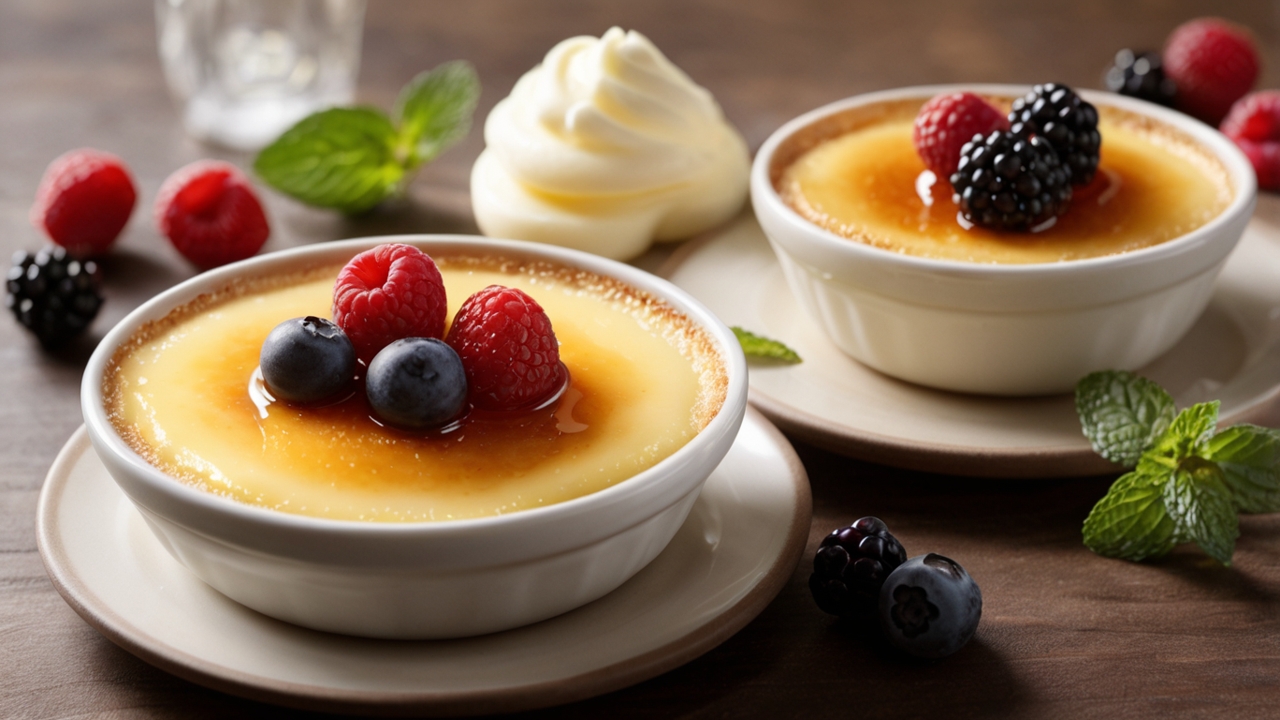Introduction
When it comes to creamy, indulgent desserts, crème brûlée and custard often come to mind. While they may seem similar, their textures, preparation techniques, and flavors reveal distinct differences. Let’s explore what sets these two desserts apart and how to master each of them.
To better understand custard’s versatility, you can read this guide to custards that explores their many types and uses. Additionally, for caramelization tips, this crème brûlée recipe offers expert advice on creating the perfect sugar crust.
What Is Custard?
Custard is a dessert made by blending milk or cream with eggs and sugar, often cooked gently to achieve a smooth texture. It serves as the base for various dishes, from pies to puddings.
- Types of Custards:
- Baked Custard: Found in desserts like flan or crème caramel.
- Stirred Custard: Used in sauces, puddings, and pastry fillings.
- Set Custard: Thickened with gelatin or cornstarch for desserts like panna cotta.
For a detailed look at custard’s role in baking, check out this comprehensive guide to custards.
What Is Crème Brûlée?
Crème brûlée is a custard dessert topped with a caramelized sugar crust. Its rich texture and satisfying crunch make it a sophisticated treat.
- Key Features of Crème Brûlée:
- Made with heavy cream and egg yolks for a silkier base.
- Caramelized sugar crust achieved with a kitchen torch or broiler.
- Typically served in individual ramekins for an elegant presentation.
To learn more about achieving the perfect caramelization, visit this step-by-step crème brûlée recipe.
Key Differences Between Crème Brûlée and Custar
1. Texture and Appearance
- Crème Brûlée:
- Features a velvety custard base with a crispy sugar crust.
- Often richer due to the use of heavy cream.
- Custard:
- Varies in firmness depending on the recipe.
- Usually lacks a caramelized sugar topping.
2. Ingredients and Ratios
- Crème Brûlée:
- Uses heavy cream and a higher ratio of egg yolks for richness.
- Custard:
- Combines milk or a milk-cream mixture with whole eggs or cornstarch.
3. Preparation Techniques
- Crème Brûlée:
- Baked in a water bath to ensure even cooking.
- Requires caramelizing sugar for the final touch.
- Custard:
- Cooked through various methods, including stovetop stirring or baking.
For more tips on dessert preparation, this caramelizing sugar guide is a valuable resource.
Creative Uses for Crème Brûlée and Custard
Crème Brûlée Variations:
- Infuse with flavors like coffee or chocolate.
- Seasonal options such as pumpkin or peppermint.
- Experiment with savory options like the Crab Brulee Recipe.
Custard Applications:
- Serve as a base for pies like lemon meringue or banana cream.
- Layer in trifles or parfaits for visual appeal.
- Use as a filling in éclairs or tarts.
FAQs
1. Is Crème Brûlée a Custard?
Yes, crème brûlée is a type of custard distinguished by its caramelized sugar topping.
2. Can Custard Be Used as a Base for Crème Brûlée?
Absolutely! The custard base provides the creamy texture for crème brûlée.
3. What’s the Best Way to Caramelize Sugar for Crème Brûlée?
Using a kitchen torch ensures even caramelization without burning the sugar.
Conclusion
While crème brûlée and custard share a similar base, their differences in texture, preparation, and presentation make each unique. Whether you’re drawn to the velvety richness of crème brûlée or the versatility of custard, mastering these desserts is a worthwhile culinary endeavor.
For further insights into these desserts, explore the QuickIRecipes blog or try creative adaptations like the Crab Brulee Recipe.

